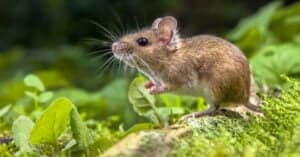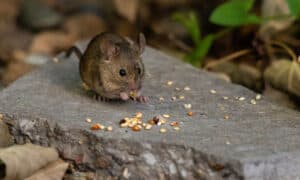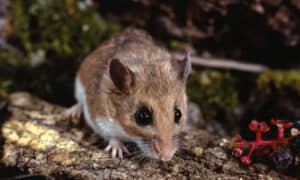Hamsters are one of the most popular rodent species to keep as pets throughout the world, and that has a lot to do with how low maintenance their diet is. When kept as pets in captivity, hamsters can be raised as gentle omnivores with relatively simple nutritional needs. Grains, seeds, and nuts are the cornerstone of the hamster’s diet both in the wild and in captivity — but dark greens and other vegetables should be a part of the diet as well. Hamsters enjoy fruit but should enjoy them in moderation as they’re prone to diabetes.
Human food like sugar, caffeine, and alcohol should be avoided. Processed hamster feed and blocks are available that help finds a nutritional balance, but many owners choose to feed their pets human food like fresh fruits and vegetables. If you feed your hamster dry food rather than human food, they should generally be fine with a tablespoon or two of feed a day. Dwarf hamsters require less food than the common Syrian hamster. Both Syrian and dwarf hamsters should be fed timothy hay for the health of their teeth rather than for its nutritional value.
Diet is a bit more complicated for hamsters in the wild. While most hamster owners aren’t in the habit of feeding their pets live animals, hamsters in the wild are actually omnivores, although meat isn’t a major part of their diet. The ideal hamster diet consists of 16% protein and 5% fat, and many nuts and seeds offer both. But hamsters in the wild can help fulfill those requirements through protein-heavy meat sources like mealworms and insects.
Syrian and dwarf hamsters are the two most popular choices for pets, but they’re just two of 18 species found in the wild. And while all of these are omnivores who eat fruits and vegetables in addition to rare pieces of meat, the specific foods that make up their diet can vary depending on their environment. In captivity, some owners will help these omnivores achieve their protein needs by providing them with pieces of boiled egg.
How Do Hamsters Find Food?
Though their diets may be roughly the same, the hunting and foraging habits of hamsters can actually vary wildly. Some rare hamsters in Africa have been observed hunting insects in packs, but most species are solitary foragers more likely to end up with a piece of meat by happenstance more than from an active attempt at hunting. Most hamster species prefer desert environments where they build elaborate burrows. These dens keep them cool during the hottest parts of the day, and they venture out only when it grows darker and cooler outside. For the most part, hamsters look to minimize their time spent outside. Most species will only journey out for about an hour after daylight and keep their time spent out in the wild as limited as possible.
Fortunately, hamsters have developed a unique quirk that helps them dramatically minimize their time spent outdoors. This helps them avoid predators, but it also keeps them insulated against the frequently frigid desert nights. Their cheeks are designed to be both highly durable and highly flexible, able to expand outward like a balloon as the hamster stuffs its mouth. With the ability to store up to 20% of their body weight inside their mouths, hamsters are capable of stockpiling food in large quantities and bringing them back to their dens. Considering that the typical wild hamster needs to eat every two hours and only has a precious window of safe time to forage, stuffing nuts, fruits and vegetables is more necessity than a convenience.
While mothers have been known to sometimes eat baby hamsters when stressed or starving, they’re generally very protective of their young. In fact, mothers will sometimes hide baby hamsters in their cheeks to carry them away to safety. Baby hamsters are nursed for about two to three weeks. After that, baby hamsters can subsist on a diet resembling those of adults — but mothers will usually continue to forage for their young for a while after.

©Kavaleuskaya Aksana/Shutterstock.com
What Animals Eat Hamsters?
The small window of time that hamsters spend foraging is a defense mechanism developed in part because of the inhospitable climate of many hamster habitats — but it’s also a reflection on how many dangerous predators there are. Hamsters are near the bottom of the food chain in most of their natural habitats, and the common medium-sized predators you’d expect to find in deserts and prairie hunt hamsters with regularity. The wide-open nature of these environments makes birds of prey, especially dangerous predators. Owls and falcons can often pluck up a hamster without stopping in flight, but they also face predation from the common buzzard.
Hamsters dig elaborate burrows as a form of protection, but they’re often a poor defense against snakes. Serpents will often be small and flexible enough to navigate through these tunnels, but they’re large enough to swallow a baby or even adult hamster whole. Rattlesnakes, king snakes, and rat snakes are some of the more common threats. On land, a variety of larger mammals pose threats all their own. Depending on the environment, hamsters might find themselves being hunted by red foxes, badgers, or jackals. In more conventional environments, hamsters are often victims of domesticated species like dogs and cats. Most of a hamster’s predators are nocturnal, as hunting them down while they’re in hiding is typically more trouble than it’s worth.
Next Up…
- The World’s 10 Favorite & Most Popular Animals
- Pets Best Pet Insurance Review: Pros, Cons and Coverage
- Guinea Pig as a Pet: How to Care for Your Guinea Pig
- What Do German Shepherds Eat?
The photo featured at the top of this post is © tanya_morozz/Shutterstock.com
FAQs (Frequently Asked Questions)
What can hamsters not eat?
There are plenty of types of human food that hamsters should stay away from. Junk food and processed human food are bad for hamsters, but there are a few human foods that are particularly worthy of note. Alcohol, caffeine, sugar, and chocolate should never make their way into a hamster’s diet. But for the most part, these are flexible omnivores that can feast on any number of fruits, vegetables, grains, nuts, and even meat.
What meat can hamsters eat?
Hamsters in the wild are technically omnivores but the only meat they usually eat is insects and mealworms. But they’re physiologically capable of digesting more complex meat as well. Hamsters can be fed bugs or worms in captivity, but they also enjoy and can benefit from cooked and high-protein meats like chicken and beef. Lean, white meats like poultry and fish are significantly healthier for hamsters than gamier red meats.
Thank you for reading! Have some feedback for us? Contact the AZ Animals editorial team.







